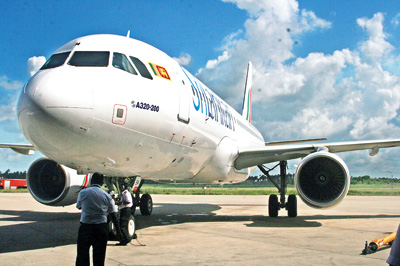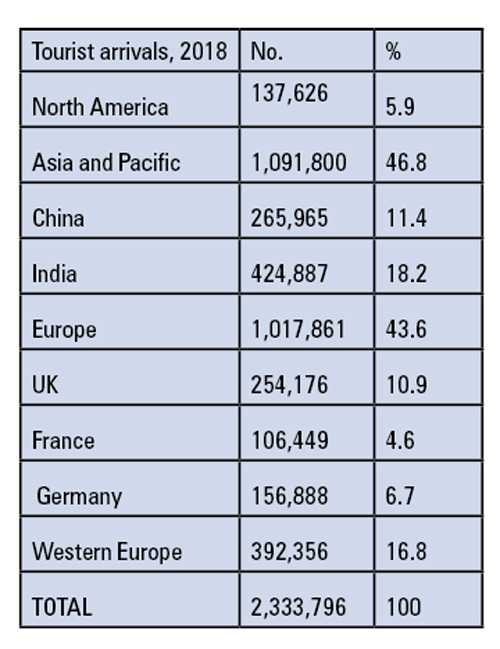Tourism: Flying without wings
View(s):Tourist arrivals to Sri Lanka have been rising fast since the end of the war. Last year, the number of tourists who came to Sri Lanka was over 2.3 million. Ten years ago in 2009, it was less than half a million.
Even with such an impressive growth of tourist arrival numbers, I believe that Sri Lanka still has a long way to go in developing its tourism industry. Among the countries in the Asian region, Malaysia receives 27 million and Thailand 33 million tourists annually.
Tourist arrivals do not depend on the size of the country, either. Singapore has received over 12 million tourists in 2016, while its total population is 5.5 million only. About 15 million annual tourist arrivals to the Netherlands amounted to over 90 per cent of its population. Tourist arrivals to France is 82 million a year, compared to its 67 million population.
As far as the tourism industry is concerned, Sri Lanka is still at the infant stage of growth after 30 years of stagnation.
Flying without wings
Europe as a tourist-originating region is as important for Sri Lanka as Asia and the Pacific, because each of these two regions generate over one million tourists to Sri Lanka. However, there are distinctions too: European tourists stay longer and spend more, compared to the tourists arriving from Asia.
In spite of all matters regarding the potential significance of Europe as an important tourism source market, what is not consistent with all efforts for tourism promotion is that there are no SriLankan Airlines flights to Europe. The only remaining flight now to Europe by the national carrier is the London flight. How do we sell a vehicle without wheels?
The London flight does not attract European passengers to London. Besides, along with anticipating Brexit just in two months, UK is separated from the European Union which would restrict movement of people between UK and EU.
About 20 years ago, the national carrier had a number of flights to many European destinations such as Amsterdam, Berlin, Frankfurt, Paris, Rome, Milan, Vienna, Munich, Stockholm, Copenhagen, Moscow and Brussels. While the SriLankan flights to some of these routes were terminated under the Emirates management, thereafter under the Sri Lankan government management other routes were also closed down.

File picture of a SriLankan Airlines aircraft.
Leading tourist nations
Among the tourism source market countries India and China occupy the first and the second positions. I don’t think this is a surprise about India’s top rank position as tourism source market for Sri Lanka, since it is a fast growing, nearest neighbouring country.
In one of my research work on Indian tourism, it was found that India’s high-spending outbound tourist flows are, actually not directed to Sri Lanka, but to the US and Western Europe. Even the “second” most affluent Indian tourists are not destined to Sri Lanka, because their preferred destinations are in East and Southeast Asia such as Singapore, Thailand, Malaysia, and Hong Kong. We haven’t captured the high-spending Indian outbound tourism either.
Compared to 425,000 arrivals from India with 1.3 billion population, Western Europe with 400 million population, generates 392,000 tourists to Sri Lanka. And the national carrier operates more than 100 flights a week to Indian destinations, and none other than the London flight to Western Europe.
Other than the UK, among the Western European countries Germany and France are the top most important countries as tourism source markets for Sri Lanka. Although tourism is promoted in Western Europe, there are no flights operated by the national carrier.
Tourism advisory services
It is more important than ad hoc tourism promotion initiatives to take note of the attitudes of tourist-originating countries towards tourist destinations. In exploring the demand-side attitudes towards Sri Lanka as an emerging popular tourist destinations, I looked at two tourism advisory services.
The following advisories to travellers to Sri Lanka are from the Foreign and Commonwealth Travel Advisory Service of the UK government and the Overseas Security Advisory Council of the US Department of State. Interestingly, what is reported in both advisory services are not much different from each other.
Sexual harassment
“Western women continue to report incidents of verbal and physical harassment by groups of men. Such harassment- ranging from sexually suggestive or lewd comments to physical advances and sexual assaults – can occur any time or anywhere, but most frequently has taken place in crowded areas such as market places, railway stations, buses, public streets and sporting events. There has been an increase in sexual attacks against females in tourist areas.”
Road safety
“Many roads, particularly outside the major towns are in a serious state of disrepair. Driving is erratic and there are frequent road accidents, particularly at night. Pedestrians and animals often appear on the road without warning. Vehicles don’t stop at pedestrian crossings. Riding a motorbike is particularly dangerous… Buses are notorious for driving fast and rarely giving way. They are often poorly maintained.”
“Street hustlers are common around popular hotels, shopping areas, and other tourist sites. Beware of tuk-tuk or taxi drivers offering tours or access to festivals or gem shops. This is a common scam that often results in tourists being heavily pressured to buy “gems” that are either cut glass or are worth much less than the price being asked.”
“Drivers are notoriously reckless, and vehicle accidents should be considered a principle threat for visitors. Travellers should drive defensively. In the event of an accident, crowds might gather and become aggressive, particularly if the accident involves a bus, tuk-tuk, or taxi.”
Dangerous train journeys
“There have been a number of fatal accidents when visitors have hung out of the open doorways or windows of trains. You should remember that there is a very real risk of death or serious injury if you do not stay within the train carriage while the train is not stopped at a station. Visitors should also be aware that there are reports of theft of travellers’ personal belongings during train journeys, including theft of briefly unattended belongings, or pick pocketing. Take care of your possessions at all times.”
“There is a scam wherein Sri Lankans in Colombo will fill trains bound for the tourist areas and take up all of the seats. They will then sell their seats to tourists and visitors for a profit and exit the train before it departs.”
Tourism and product quality
Sri Lanka has also being named in the recent past as one of the best tourist destinations in the world. Apparently, there are positive attributes of the Sri Lankan tourism industry which I didn’t highlight in this column. My focus was basically on drawing attention to improve its demand-driven supply.
Tourism is a service product, produced not by individual producers and companies; it is a very specific competitive product supplied by a “nation” and the demand is highly sensitive to destination market conditions. Therefore, it has to be supplied delicately and collaboratively by many industries, organisations, government agencies and even individuals.
Every citizen that a tourist meets or sees in any place is a “promoter” for the tourism industry and an “ambassador” for the nation. The positive effects of hundreds and thousands of events and circumstances can be wiped out by one bad experience of a tourist.
Given this very specific nature of the tourism industry, what measures does the authorities take in delivering a competitive tourism product? This is a timely policy issue.
(The writer is a Professor of Economics at the University of Colombo and can be reached at sirimal@econ.cmb.ac.lk)


